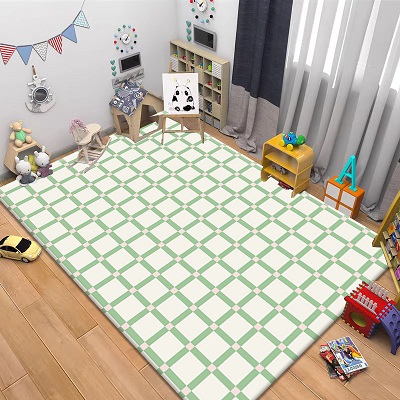Play rugs have become an essential part of many children’s playrooms, offering more than just a soft surface for playtime. These versatile mats with their colorful designs and interactive elements provide numerous benefits, one of which is fostering spatial awareness in children.
Benefits of spatial awareness
In this article, we explore how play rugs contribute to children’s spatial cognition and understanding of the world around them.

1. Creating a Sense of Place
Play rugs often feature detailed designs, such as cityscapes, roads, or nature scenes, that mimic real-world environments. By interacting with these settings, children develop a sense of place, and an understanding the layout and structure of different spaces.
2. Navigating and Directional Skills
The various elements of play rugs, such as roads, pathways, or landmarks, encourage children to practice navigation and directional skills. As they move toy cars or figurines across the rug, children learn to follow routes and make spatial connections.
3. Developing Spatial Language
Play rugs become a platform for introducing spatial language, such as over, under, next to, behind, and between. Children naturally incorporate these terms into their play as they interact with different elements on the rug.
4. Encouraging Visual-Spatial Reasoning
The interactive features on play rugs, such as puzzles or shape-sorting activities, stimulate visual-spatial reasoning. Children must analyze the relationship between shapes, colors, and patterns, enhancing their problem-solving skills.
5. Grasping Proportions and Scale
Through play on the rug, children develop an understanding of proportions and scale. They can compare the sizes of different objects or buildings on the rug, fostering a sense of relative sizing.
6. Building 3D Thinking
Some play rugs have raised elements or structures, such as buildings or mountains, which contribute to 3D thinking. Children can visually and physically explore these elements, developing their spatial visualization skills.
7. Encountering Perspectives and Angles
As children move around the play rug, they encounter different perspectives and angles of the design. This exposure helps them grasp how spatial elements appear differently from various viewpoints.
8. Promoting Spatial Memory
Repetitive play on the same play rug can enhance spatial memory as children become familiar with the layout and details of the design. They can recall the locations of specific elements and incorporate this knowledge into their play.
9. Spatial Relationships and Object Manipulation
Play rugs provide opportunities for children to understand spatial relationships between objects. They can arrange toys or objects in specific patterns or formations, improving their object manipulation skills.
10. Preparing for STEM Learning
Spatial awareness is a crucial foundation for future learning in science, technology, engineering, and mathematics (STEM). Developing these skills through play rugs prepares children for future spatial tasks and challenges.

Conclusion
Play rugs serve as valuable tools for enhancing spatial awareness in children. From navigating imaginary landscapes to developing spatial language and reasoning, the interactive and visually stimulating nature of play rugs offers a myriad of benefits for spatial cognition.
As children engage in play on the rug, they build a mental map of their play environment, fostering a deeper understanding of spatial relationships and structures. So, let the play rug be a gateway to spatial exploration, where children’s cognitive abilities and understanding of space grow hand in hand, unlocking a world of possibilities for their future learning and development.

